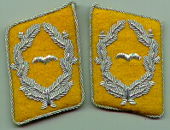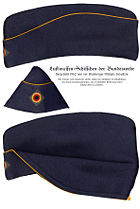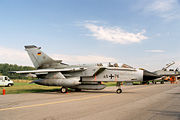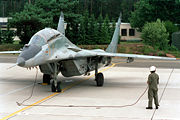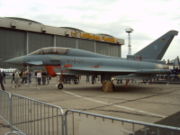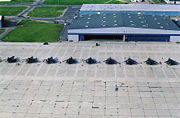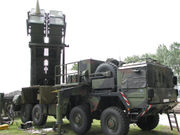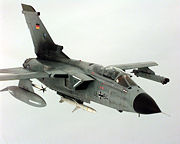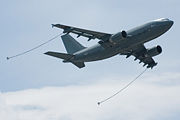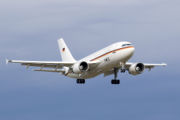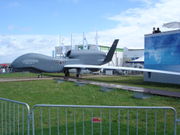Luftwaffe
2008/9 Schools Wikipedia Selection. Related subjects: World War II
| Luftwaffe | |
|---|---|
 |
|
| Founded | 1910-1919; 1924-1933; 1933-1946; 1956-1990; 1990-current |
| Country | Germany |
| Size | 62,700 personnel 620 aircraft |
| Insignia | |
| Roundel |
 |
| Aircraft flown | |
| Attack | Tornado |
| Electronic warfare |
Tornado |
| Fighter | F-4 Phantom II, Eurofighter |
| Trainer | T-38 Talon, G-120, T-37 |
| Transport | Challenger 600, A310, Cougar, C-160 |
Luftwaffe (German IPA: ['luftvafə]) is a generic German term for an air force. It is also the official name for two of the four historic German air forces, the Wehrmacht air arm founded in 1933 and disbanded in 1946; and the current Bundeswehr air arm founded in 1956. Two other historic German air forces are the World War I-era Luftstreitkräfte and the Luftstreitkräfte der NVA in the GDR. Additionally, Luftwaffe is also the name of the Swiss Air Force in German (Forces aériennes suisses in French and Forze Aeree Svizzere in Italian). The air force of Austria is called Österreichische Luftstreitkräfte.
History
World War I
The forerunner of the Luftwaffe, the Imperial German Army Air Service ( Luftstreitkräfte), was founded in 1910 with the emergence of military aircraft, although they were intended to be used primarily for reconnaissance in support of armies on the ground, just as balloons had been used in the same fashion during the Franco-Prussian War of 1870–1871 and even as far back as the Napoleonic Wars. It was not the world's first air force, however, because France's embryonic army air service, which eventually became the French Air Force (Armée de l’Air), had also been founded in 1910. Britain's Royal Flying Corps (which merged in 1918 with the Royal Naval Air Service to form the Royal Air Force) was founded in 1912.
During World War I, the Imperial Army Air Service utilised a wide variety of aircraft, ranging from fighters (such as those manufactured by Albatros-Flugzeugwerke and Fokker) to reconnaissance aircraft (Aviatik and DFW) and heavy bombers ( Gothaer Waggonfabrik, better known simply as Gotha, and Zeppelin-Staaken).
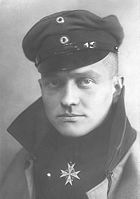
However, the fighters received the most attention in the annals of military aviation, since it produced aces such as Manfred von Richthofen, popularly known as the Red Baron (der rote Baron), Ernst Udet, Hermann Göring, Oswald Boelcke, Werner Voss, and Max Immelmann (the first airman to win the Pour le Mérite, Imperial Germany's highest decoration for gallantry, as a result of which the decoration became popularly known as the Blue Max) . As did the German Navy, the German Army used Zeppelins as airships for bombing military and civilian targets in France and Belgium as well as the United Kingdom.
All German and Austro-Hungarian military aircraft in service used the Iron Cross insignia until early 1918. Afterwards, the Balkenkreuz, a black Greek cross on white, was introduced.
After the war ended in German defeat, the service was dissolved completely under the conditions of the Treaty of Versailles, which demanded that its aeroplanes be completely destroyed. As a result of this disbanding, today's Luftwaffe (which dates from 1956) can not claim to be the oldest independent air force in the world, since the Royal Air Force of the United Kingdom is older, having been founded on April 1, 1918.
Interwar period
Since the Treaty of Versailles forbade Germany from having an air force, German pilots had to be trained in secret. Initially, civil aviation schools within Germany were used, yet only light training planes could be used in order to maintain the facade that the trainees were going to fly with civil airlines such as Lufthansa. To train its pilots on the latest combat aircraft, Germany solicited the help of its future enemy, the USSR, which was also isolated in Europe. A secret training airfield was established at Lipetsk in 1924 and operated for approximately nine years using mostly Dutch and Russian, but also some German, training aircraft before being closed in 1933. This base was officially known as 4th squadron of the 40th wing of the Red Army.
On February 26, 1935, Adolf Hitler ordered Hermann Göring to establish the Luftwaffe, breaking the Treaty of Versailles's ban on German military aviation. Germany violated the treaty without sanction from Britain and France or the League of Nations, and neither they nor the league did anything to oppose this. Although the new air force was to be run totally separately from the army, it retained the tradition of according army ranks for its officers and airmen, a tradition retained today by united Germany's Luftwaffe and by many air forces throughout the world. It is worth noting, however, that before the official promulgation of Göring's new Luftwaffe in 1935, Germany had a paramilitary air force known as the Deutscher Luftsportverband (DLV: German air sports union). The DLV was headed by Ernst Udet and its insignia were taken over by the new Luftwaffe, although the DLV "ranks" had special names that made them sound more civilian than military.
Dr. Fritz Todt, the engineer who founded the forced labor Organisation Todt, was appointed to the rank of Generalmajor in the Luftwaffe. He was not, strictly speaking, an airman, although he had served in an observation squadron during World War I and had been awarded the Iron Cross. He died in a plane crash in February 1942.
Hermann Göring personally chose an insignia for the Luftwaffe that differed from that of the other armed branches. The eagle, an old symbol of the German Empire, was used, but in a different posture. Since 1933, when Hitler's National Socialist Party came to power, the eagle held between his claws the symbol of the party—the swastika (an old symbol of sunrise)—which usually was enveloped by an oak wreath. Göring rejected the old heraldic eagle because he felt it was too stylized, too static, and too massive; instead he chose a younger, more natural and lighter eagle with wings spread as if in flight, as he considered this a more suitable symbol for an air force. While the Wehrmacht eagle held the symbol of the Nazi Party firmly in its claws, the Luftwaffe eagle held the swastika with only one claw while the other was bent in a threatening gesture.
The Luftwaffe had the ideal opportunity to test its pilots, aircraft and tactics in the Spanish Civil War of 1936–1939, when the Condor Legion was sent to Spain in support of the anti-Republican government revolt led by Francisco Franco. Modern machines included names which would become world famous: the Junkers Ju 87 Stuka dive-bomber, Dornier Do 17 "Schnell" (fast) bomber, and the Messerschmitt Bf 109 fighter plane. However, since the aircraft were seconded to Franco's Nationalist air force, Luftwaffe markings were replaced to avoid giving the world the impression that Germany was actively supporting the revolt. Instead of the Nazi Party's swastika on the tail, the German planes used the nationalist air force aircraft markings (a Saint Andrew's cross over a white background, painted on the rudder of the aircraft and a black disc on fuselage and wings). All aircraft in the Legion were affiliated to units given a designation ending in the number 88. For example, bombers were in Kampfgruppe (combat group) 88, abbreviated K/88; and fighters, in Jagdgruppe (fighter group) 88, J/88.
A grim foretaste of the systematic bombing of cities during World War II came in April 1937 when a combined force of German and Italian bombers under Spanish-Nationalist command destroyed most of the Basque city of Guernica in north-east Spain. This bombing received worldwide condemnation, and the collective memory of the horror of the bombing of civilians has ever since become most acute via the famous painting, named after the town, by the Cubist artist Pablo Picasso. Many feared that this would be the way that future air wars would be conducted, since the Italian strategist, General Giulio Douhet (who had died in 1930), had formulated theories regarding what would be dubbed "strategic bombing", the idea that wars would be won by striking from the air at the heart of the industrial muscle of a warring nation, and thus demoralising the civilian population to the point where the government of that nation would be driven to sue for peace—a portent of things to come, certainly, and not just during the war which would break out in Europe only months after the end of the civil war in Spain.
World War II
At the outset of the war, the Luftwaffe was one of the most modern, powerful, and experienced air forces in the world, dominating the skies over Europe with aircraft much more advanced than their counterparts. The Luftwaffe was central to the German Blitzkrieg (lightning war) doctrine, as the close air support provided by various medium two-engine bombers, Stuka dive bombers and an overwhelming force of tactical fighters were key to several early successes. Unlike the British and American Air Forces, the Luftwaffe never developed four-engine bombers in any significant numbers, and was thus unable to conduct an effective long-range strategic bombing campaign against either the Russians or the Western Allies. The Messerschmitt Bf 109 was the most versatile and widely-produced fighter aircraft operated by the Luftwaffe and was designed when biplanes were still standard. Many versions of this aircraft were made. The engine, a liquid cooled Mercedes-Benz DB 601, initially generated up to almost 1,000 horsepower (750 kW). This power increased as direct fuel injection was introduced to the engines. The kill ratio (almost 9:1) made this plane far superior than any of the other German fighters during the war (the closest being the Focke-Wulf Fw 190 at 4:1). The Focke Wulf Fw 190 was considered one of the best German fighters of World War II, second only to the Messerschmitt Bf 109. It had relatively short wings and was powered by a radial BMW engine. The Junkers Ju 87 Stuka was a main asset for Blitzkrieg, able to place bombs with deadly accuracy. The leader of the Luftwaffe was Hermann Göring, a World War I fighter ace and former commander of Manfred von Richthofen's famous JG 1 (aka " The Flying Circus") who had joined the Nazi party in its early stages. In the summer and autumn of 1940, the Luftwaffe lost the Battle of Britain over the skies of England, the first all-air battle. Following the military failures on the Eastern Front, from 1942 onwards, the Luftwaffe went into a steady, gradual decline that saw it outnumbered and overwhelmed by the sheer number of Allied aircraft being deployed against it. Towards the end of the war, the Luftwaffe was no longer a major factor, and despite fielding advanced aircraft like the Messerschmitt Me 262 and Me 163, was crippled by fuel shortages and a lack of trained pilots.
Cold War
|
|||||||||||||||||
German aviation in general was severely curtailed, and military aviation was completely forbidden when the Luftwaffe was officially disbanded in August 1946 by the Allied Control Commission. This changed when West Germany joined NATO in 1955, as the Western Allies believed that Germany was needed in view of the increasing military threat posed by the Soviet Union and its Warsaw Pact allies. Throughout the following decades, the West German Luftwaffe (Bundesluftwaffe: federal air force) was equipped mostly with U.S.-designed aircraft manufactured locally under license. All aircraft sported—and continue to sport—the Iron Cross on the fuselage, harking back to the days of World War I, while the national flag of West Germany is displayed on the tail.
Many well-known fighter pilots who had fought with the Luftwaffe in World War II joined the new post-war air force and underwent refresher training in the U.S. before returning to West Germany to upgrade on the latest U.S.-supplied hardware. These included Erich Hartmann, the highest-ever scoring ace (352 enemy aircraft destroyed), Gerhard Barkhorn (301), Günther Rall (275) and Johannes Steinhoff (176). Steinhoff, who suffered a crash in a Messerschmitt Me 262 shortly before the end of the war that resulted in lifelong scarring of his face and other parts of his body, would eventually become commander-in-chief of the Luftwaffe, with Rall as his immediate successor. Hartmann retired as an Oberst ( colonel) in 1970 at age 48. Josef Kammhuber, mentioned above, also served in the post-war Luftwaffe, retiring in 1962 as Inspekteur der Bundesluftwaffe (chief inspector of the Federal air force).
During the 1960s, the " Starfighter crisis" developed into a political issue, as many of these Lockheed F-104 fighters crashed after being modified to serve for Luftwaffe purposes—specifically for terrain, weather and ground troop support issues. In Luftwaffe service, 292 of the 916 Starfighters crashed, claiming the lives of 115 pilots and leading to cries that the Starfighter was fundamentally unsafe from the West German public, which referred to it as the Witwenmacher (widow-maker), fliegender Sarg (flying coffin), and Erdnagel (ground nail).
Steinhoff and his deputy Rall noted that the non-German F-104s proved much safer—Spain, for example, lost none in the same period. The Americans blamed the high loss rate of the Luftwaffe F-104s on the extreme low-level and aggressive flying of German pilots rather than any faults in the aircraft.. Steinhoff and Rall immediately left their daily work and learned to fly the aircraft in America under Lockheed instruction and noted some specifics in the training (a distinct lack of mountains and foggy weather training), combined with handling capabilities (sharp start high G turns) of the aircraft that could create accident situations.
Steinhoff and Rall immediately changed the training regimen for the F-104 pilots, and accident ratios quickly fell to those comparable or better than other air forces. They also brought about the high level of training and professionalism seen today throughout the Luftwaffe, and the start of a strategic direction for Luftwaffe pilots to tactically and combat train outside Germany. However, the F-104 never lived down its reputation as a widow-maker and was replaced much earlier by the Luftwaffe than other national air forces.
1970s
From 1965 through 1970, two surface to surface missile wings (Flugkörpergeschwader) fielded 16 of the Pershing I missile systems with nuclear warheads under U.S. Army custody. In 1970, the system was upgraded to Pershing IA with 72 systems. Although not directly affected by the 1988 Intermediate-Range Nuclear Forces Treaty, the Luftwaffe unilaterally agreed to the retrograde of the Pershing IA system from their inventory in 1991, and the missiles were destroyed.
Beginning in June 1979, the Luftwaffe took delivery of 212 Panavia Tornado IDSs.
The United States provides nuclear weapons for use by Germany under a NATO nuclear sharing agreement. As of 2007, only 22 B61-4s are provided, stored at Büchel Air Base for delivery with German Air Force Tornado IDS. They will likely be withdrawn when the Tornados at Büchel are replaced with Eurofighter Typhoons after 2012, as it is not planned to integrate the B-61 bomb into the Eurofighter. B-61s stationed at Nörvenich and Memmingen Air Base (fighter-bomber wing JaBoG 34 "Allgäu") have already been withdrawn in the mid to late nineties. All bombs formerly stored at Ramstein Air Base have been brought back to the US due to ongoing construction work at Ramstein AB and will not be returned.
Reunification

The GDR air force, the Luftstreitkräfte der NVA, was supplied exclusively with Eastern Bloc-produced aircraft such as the Sukhoi Su-17 Fitter and the more famous Mikoyan-Gurevich (MiG) family of aircraft, such as the MiG-21, MiG-23 and MiG-29 fighters, and served primarily as an extension of Red Air Force units in Eastern Germany. The East German Air Force was unique among Warsaw Pact countries in that it was often equipped with Soviet-standard combat aircraft instead of downgraded export models, though operated an extension of Soviet air power, the East German Air Force enjoyed less autonomy than other Eastern Bloc air forces. Unlike the West German Luftwaffe, the markings sported on the aircraft reflected the identity of the country as belonging to the Communist bloc. These markings consisted of a diamond-shaped design, in which could be seen the vertically oriented three stripes in black, red and gold surmounted by the stylized hammer, compass and wreath-like ears-of-grain design, which was also on the Flag of East Germany, although the stripes were a 90-degree orientation from those to be seen on either national flag of the two German nations between 1959 and 1990.
After East and West Germany were reunified in October 1990, the aircraft of the NVA were taken over by the unified Federal Republic of Germany, and their GDR markings were replaced by the Iron Cross, thus creating the singular situation of Soviet-built aircraft serving in a NATO air force. However, most of these would eventually be taken out of service altogether, in many cases being sold to the new Eastern European allies now part of NATO, such as Poland and the Baltic states.
The exception to this was the Jagdgeschwader 73 "Steinhoff" (Fighter Wing 73 Steinhoff) stationed in Laage. The pilots of the JG 73 flew MiG-29s acquired during the reunification and were some of the most experienced MiG-29 pilots in the world. One of their primary duties was to serve as aggressor pilots, training other pilots in dissimilar combat tactics. The United States sent a group of fighter pilots to Germany during the Red October exercise to practice real tactics against the aircraft they were most likely to meet in real combat. In 2004, however, the MiG-29s were sold to Poland. Since then, pilots of the JG 73 fly the Eurofighter Typhoon.
1990s
In March 1999, for the first time since 1945, the Luftwaffe engaged in combat operations as part of the NATO-led Kosovo War. This event was noted as significant in the British press with The Sun running the headline "Luftwaffe and the RAF into battle side by side". The Luftwaffe flew suppression of enemy air defence ( SEAD) sorties. No Luftwaffe aircraft were lost during the campaign, but the force's role proved to be controversial in Germany because Germany was not and, indeed, still is not allowed to participate in "wars of aggression" owing to its 1949 constitution ( Grundgesetz). In addition to constitutional concerns, strong pacifist sentiment is present in the population that is opposed to the use of force by Germany in international affairs.
2000s
In 2005, four F-4F Phantoms participated on NATO's Baltic Air Policing operation.
In 2006, to support coalition operations across Afghanistan, the Luftwaffe deployed Panavia Tornado reconnaissance aircraft from Aufklärungsgeschwader 51 "Immelmann" (the 51st Reconnaissance Wing Immelmann), stationed in Mazar-i-Sharif, Northern Afghanistan.
Future
Since the 1970s, the Luftwaffe of West Germany and later the reunited Germany (as well as many other European air forces) has actively pursued the construction of European combat aircraft such as the Panavia Tornado and, more recently, the Eurofighter Typhoon, which was introduced in 2006.
On January 13, 2004, the then-German Defence Minister Peter Struck announced major changes to the German armed forces. A major part of this announcement was a plan to cut the German fighter fleet from 426 aircraft in early 2004 to 265 by 2015. Assuming the full German order for 180 Eurofighter Typhoons is fulfilled, this will see the Tornado force reduced to 85. The German Navy's air wing (Marineflieger) received 112 Tornado IDSs. In late 2004 the last Tornado unit was disbanded. The maritime combat role has been assumed by the Luftwaffe, a unit of which has had its Tornados upgraded to carry the Kormoran II and AGM-88 HARM missiles.
Tactical Training Centers
In light of the destroyed infrastructure of West Germany post-World War II, the restrictions on aircraft production placed on Germany and the later restrictive flying zones available for training pilots, the reconstructed Luftwaffe trained most of its pilots tactically away from Germany, mainly in the U.S. where most of its aircraft were sourced.
During the 1960s and 1970s, a very large number of Luftwaffe jet crashes—the Luftwaffe suffered a 36 percent crash rate for F-84F Thunderstreaks and an almost 30 percent loss of F-104 Starfighters—created considerable public demand for moving Luftwaffe combat training centres away from Germany.
As a result, the Luftwaffe set up two tactical training centres: one, like those of many of the NATO forces, at the Canadian Forces Air Command base at Goose Bay; and the second in a unique partnership with the United States Air Force at Holloman Air Force Base in New Mexico. Both facilities provide access to large unpopulated areas, where tactical and combat training can take place without danger to large populations.
In September 2004, the Luftwaffe’s chief of staff, Klaus-Peter Stieglitz, announced a reduction in its training program of roughly 20%.
Holloman Air Force Base
On May 1, 1996, the Luftwaffe established the German Air Force Tactical Training Centre (TTC) in concert with the United States Air Force 20th Fighter Squadron, which provides aircrew training in the F-4F Phantom II. The TTC serves as the parent command for two German air crew training squadrons. The F-4 Training Squadron oversees all German F-4 student personnel affairs and provides German instructor pilots to cooperate in the contracted F-4 training program provided by the U.S. Air Force (20th Fighter Squadron). A second TTC unit, the Tornado Training Squadron, provides academic and tactical flying training, by German air force instructors, for German Tornado aircrews.
The first contingent of Tornado aircraft arrived at Holloman in March 1996. More than 300 German air force members are permanently assigned at Holloman to the TTC, the only unit of its kind in the United States. The German Air Force Flying Training Centre activated on March 31, 1996, with German Air Force Chief of Staff Gen. Portz and U.S. Air Force Chief of Staff Gen. Michael Ryan present. The Luftwaffe has since stationed up to 800 personnel at Holloman for training exercises, due to limited training space in Europe.
Organization
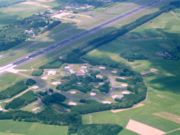
Current Structure of the German Luftwaffe down to Squadron-level, as of 20th of December 2007
- Inspektor of the Airforce (Currently: Lieutenant General Klaus-Peter Stieglitz)
- Air Force Command Staff at the Federal Ministry of Defence
Air Force Command
- HQ Squadron
- Command of Aerial Forces
- HQ Squadron
- National Aerospace Defence Command
- Support Service Command of the Air Force
| 1st Air Force Division | 2nd Air Force Division | 4th Air Force Division | Air Transport Command |
|---|---|---|---|
| HQ Squadron | HQ Squadron | HQ Squadron | HQ Squadron |
| 1st Air Force Band | 2nd Air Force Band | 4th Air Force Band | |
| 1st Aerial Region Command | 3rd Aerial Region Command |
|
|
5th Aerial Defence Wing
|
2nd Aerial Defence Wing
|
1st Aerial Defence Wing
|
|
|
32nd Ground-attack Wing
74th Fighter Wing
|
31st Ground-attack Wing “ Boelcke”
33rd Ground-attack Wing
73rd Fighter Wing “Steinhoff”
|
71st Fighter Wing " Richthofen"
51st Reconnaissance Wing “Immelmann”
|
Ministerial Transport Readiness Wing
61st Air Transport Wing
62nd Air Transport Wing
63rd Air Transport Wing
|
| Tactical Training Command, Italy | Air Force Regiment “Frisia”
|
A Flying Wing of the German Luftwaffe is usually structured like this:
Wing
- HQ & HQ Squadron
- Flying Group
- HQ & Support Platoon
- 1st Flying Squadron
- 2nd Flying Squadron
- Airfield Squadron
- Geophysical Service Centre
- Technical Group
- HQ & Support Platoon
- Repair Squadron
- Maintenance & Weapons Squadron
- Supply & Transport Squadron
An Aerial Defence Group consists of a HQ Squadron, four Aerial Defence Squadrons and a support squadron.
Air Force Office
- HQ Support Squadron
- Surgeon General of the Air Force
- Office for Air-Traffic Control of the Air Force
| Air Force Training Command | Weapon System Command of the Air Force | Air Force Regional Command USA/ Canada |
|---|---|---|
| HQ Company | HQ Company | HQ Company |
|
|
|
Aircraft inventory
| Aircraft | Origin | Type | Versions | In service | Notes |
|---|---|---|---|---|---|
| Airbus A310 | transport tanker |
A310-304 A310 MRTT |
7 | ||
| Airbus A319CJ | VIP transport | Airbus A319-114CJ | 0 | 2 ordered | |
| Airbus A340 | VIP transport | Airbus A340-300 | 0 | 2 ordered | |
| Airbus A400M | transport/tanker | Airbus A400M | 0 | 60 on order | |
| UH-1 Iroquois | utility helicopter | UH-1D | 73 | built by Dornier | |
| Bombardier Challenger 600 | VIP transport | CL-601 | 6 | ||
| EuroHawk | SIGINT | RQ-4B Block 20 | 0 | 5 on order; to be built by Northrop Grumman and equipped with an EADS reconnaissance payload | |
| Global Express 5000 | VIP transport | Bombardier Global Express 5000 | 0 | 4 ordered | |
| Cessna T-37 Tweet | trainer | T-37B | 47 | flying under USAF roundel | |
| Eurocopter Cougar | transport helicopter | AS 532U-2 | 3 | ||
| Eurofighter Typhoon | fighter | EF-2000 | 40 | another 140 under delivery | |
| Grob G-120 | trainer | G-120 | 6 | Civilian operated at Goodyear, Arizona (USA) | |
| McDonnell-Douglas F-4 Phantom II | fighter | F-4F | 44 | In service until 2012 (to be replaced by Eurofighter Typhoon) | |
| NHI NH90 | transport + CSAR | NH90 TTH | 4 | 38 on order (+12 options) | |
| Northrop T-38 Talon | trainer | T-38 | 46 | flying under USAF roundel | |
| Panavia Tornado | electronic warfare attack/reconnaissance |
Tornado ECR Tornado IDS |
34 186 |
||
| Transall C-160 | tactical transport | C-160D | 83 |

